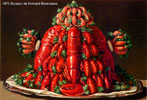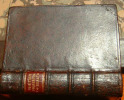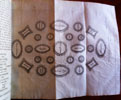THE ROYAL COOKERY BOOK
(LE LIVRE DE CUISINE) BY JULES GOUFFE CHEF DE CUISINE OF THE PARIS JOCKEY CLUB TRANSLATED FROM THE FRENCH AND ADAPTED FOR ENGLISH USE BY ALPHONSE GOUFFE HEAD PASTRY-COOK TO HER MAJESTY THE QUEEN COMPRISING DOMESTIC AND HIGH-CLASS COOKERY ILLUSTRATED WITH SIXTEEN LARGE PLATES PRINTED IN COLOUR, AND ONE HUNDRED AND SIXTY-ONE WOODCUTS FROM DRAWINGS FROM NATURE BY E. RONJAT. [with an illustration of a fore-rib of beef] LONDON SAMPSON LOW, SON, MARSTON CROWN BUILDINGS, 188 FLEET STREET 1868 (All rights reserved)
FIRST ENGLISH EDITION. 245x170mm. 2feps. Half title with advertisement on verso. [1] Coloured Frontispiece with tissue guard. Title page in red and black text (with illustration of a beef forerib). [1] 1+vi Translators preface. (1)viii-xiii Preface. [1] (1)xvi Illustrations. (1)xviii Contents. 1p Part the First. [1] (1)4-671. [1] (1)674-677 Appendix. [1] (1)680-700 Index. (1)702 Index to Woodcuts. (1) Index to Cloured Plates. [1] 1fep. With the full original dark burgundy cloth binding and the elaborate gilt tolling on the spine and front boards. The spine has been expertly re-laid and strengthened and the gilt tooling is nice and bright all over. All edges gilt. Text block is tight and very clean. A fantastic copy in the original state.
- Jules Gouffe wrote very eloquently - "Having, from my earliest youth, embarked upon a career of cookery, I saw much, observed much, practised much in every sense of the word. I am not one of those who declare that French cookery, that part of our national heritage of which we have reason to be proud, is lost today and that it will never recover. The good and true things never die. No doubt there may be periods of decline, but sooner or later, with hard work, intelligence and good will, there must be a recovery. If, thanks to the reforms and the methods which I propose, I find that in a few years' time everyone, whatever his rank in society, is eating as well as he possibly can. On the one hand, household cookery is at last being carried on with care, economy and comfort; on the other hand, the ‘grande cuisine' goes forward under progressive conditions, and with that good taste and brilliance which is so appropriate to a century of enlightenment and luxury like our own; then I shall have truly attained the goal which I have set myself, I shall feel myself well paid for all my pains.” Gouffe wrote four major works in French. They have all have been translated into English by Alphonse Gouffé, his brother who was also the Head Pastry Chef of Queen Victoria. 1. Le livre de cuisine – the ‘The Royal Cookery Book’ in English it was rated as one of the finest cookbooks ever written. 2. Le livre de patisserie- The Royal Book of Pastry and Confectionery highlighting the methods of creating ‘pièces montées’ was published in 1873 by Librairie Hachette. 3. Le livre des conserves- The Book of Preserves by Jules Gouffe was also published in 1873. 4. Le livre des soupes et des potages- This book by Gouffe contained more than 400 soup recipes. He died at Neuilly in 1877.






click on image to enlarge

Antiquarian category
ref number:
11199 













































